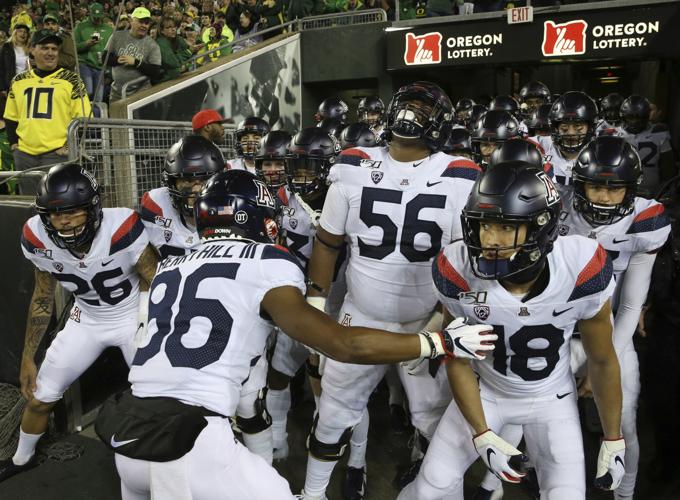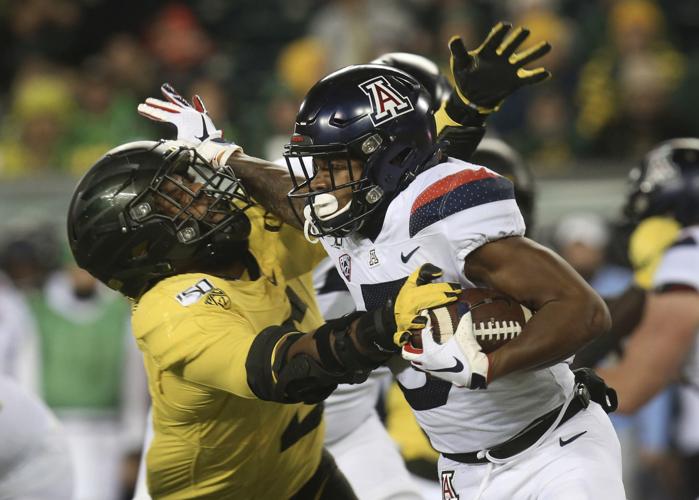Unfortunately for the Arizona Wildcats, their next opponent bears a striking resemblance to their last opponent.
It extends far beyond their matching 9-1 records and back-to-back positioning in the latest College Football Playoff ranking.
Seventh-ranked Utah, which visits Arizona Stadium on Saturday night, ranks third in the Pac-12 in scoring (34.7 ppg). No. 6 Oregon, which drummed Arizona last week in Eugene, ranks second (37.8).
Utah ranks fourth in total offense; Oregon ranks third. The way they do it is different — the Utes are more run-oriented — but the bottom-line production is almost identical: Utah averages 455.4 yards per game, Oregon 460.4.
In each of the following categories, the Utes and Ducks rank first or second in the league: third-down percentage, points allowed, total defense, passing defense, rushing defense, third-down defense, interceptions, defensive touchdowns and turnover margin.
They aren’t exactly the same, of course. Neither are the circumstances — or, critically, the setting.
If you’re Arizona, you can’t play the same game as last week and hope to have any chance to win.
In this week’s “Cats Stats,” we’ll examine two specific areas that torpedoed the Wildcats at Autzen Stadium. Solving those problems doesn’t necessarily mean they’ll win. But if they don’t, they won’t have a shot.
The first issue is third down, where Arizona converted only 5 of 17 attempts. The Wildcats’ 29.4% conversion rate wasn’t their worst of the season. Their 12 failed conversions were a season high.
We explored third-down percentage previously this season. We determined that for Arizona — and most teams, probably — what happens on the preceding downs significantly impacts third-down success rate.
In short — and this isn’t exactly “Hidden Figures”-level mathematics here — the more yards you need to gain, the harder it is to convert.
If it felt like the Wildcats were in third-and-long situations all night against the Ducks, well, you weren’t imagining things. On average, Arizona needed to gain 7.8 yards to convert on third down. On seven occasions, the Wildcats needed 10 or more yards.
Arizona wasn’t proficient at any distance against Oregon. The Wildcats converted only 2 of 7 third downs (28.6%) when needing 10-plus yards. One came on Khalil Tate’s 21-yard scramble on third-and-15 in the second quarter. The other came on J.J. Taylor’s 21-yard reception from Tate on third-and-10 later in the period.
(Interesting aside: Utah is the only Pac-12 team that hasn’t faced a healthy Tate. He hadn’t become the starter yet when the Wildcats hosted the Utes in September 2017. When Arizona visited Utah last year, Tate came in banged up and didn’t last past the first quarter.)
What were some of the issues that created those third-and-long scenarios? Let’s take a quarter-by-quarter look:
FIRST QUARTER
Third-and-14, UA 19-yard line: A 5-yard penalty for an illegal shift turned a third-and-long into a third-and-all-but-impossible. The preceding plays were an incomplete pass by Grant Gunnell and a 1-yard run by Taylor. On third-and-14, Gunnell got sacked.
SECOND QUARTER
Third-and-15, UA 25: This was the aforementioned Tate scramble. A dropped pass by Gary Brightwell and a Tate run for minus-5 yards preceded it.
Third-and-13, UA 43: Same drive. Tate again scrambles, but this time is funneled to the sideline and gains no yards. The preceding sequence: incomplete pass, 2-yard run, false start.
Third-and-10, UO 48: This was the aforementioned Tate pass to Taylor, who caught the ball at the 43, scooted around cornerback Deommodore Lenoir and dragged him for extra yardage. The two preceding plays: an incomplete pass and a Tate rush for no gain.

Oregon’s Kayvon Thibodeaux, left, tackles Arizona’s Brian Casteel. The Wildcats struggled mightily on third down against the Ducks, converting only five of 17 opportunities.
THIRD QUARTER
Third-and-12, UA 23: Tate throws an incomplete pass, forcing the Wildcats to punt. The sequence commenced with a false start, which immediately put the Wildcats behind the chains. They began the first possession of each half with a false-start penalty.
Third-and-13, UA 13: Tate rushes for a loss of 4 yards to force another punt. Two plays earlier, the Ducks dropped Brian Casteel for a 5-yard loss on a jet-sweep shovel pass, creating second-and-15. A Taylor rush for 2 yards set up third-and-13.
FOURTH QUARTER
Third-and-13, 50-yard line: This happened on the penultimate possession of the game. Gunnell is back behind center and he gets sacked for a 3-yard loss. He also got sacked on first-and-10, leading to second-and-13. The next play: an incomplete pass.
So what are the lessons here? No. 1, presnap penalties are an absolute killer, especially against high-quality opponents. Arizona had five of those against Oregon. That shouldn’t be as big a problem against Utah with the game taking place in Tucson and the new-look offensive line having a bit more experience.
No. 2, negative-yardage or no-yardage plays are just as harmful. Our suggestion to mitigate them: Be more patient with the run game and call more high-percentage passes (e.g., bubble screens). Even 2- or 3-yard gains can help create more manageable third-down scenarios.
The other major issue is another that we have addressed from time to time in this space: field position.
Multiple factors contribute to field-position differentials. Arizona’s deficit in average starting field position against Oregon wasn’t that bad – minus-5 yards. But it was the ninth time in 10 games that the Wildcats had a deficit.
The Wildcats didn’t turn the ball over and took it away once – returning an interception from the UA 6 to the 48 – and that helped minimize the damage. But the Ducks still started three possessions in Arizona territory.
Oregon obtained the ball via punts that traveled 28, 22 and 32 yards.
It was a rough night for freshman punter Kyle Ostendorp, and it’s been a rough year for Arizona’s punters overall. Ostendorp and senior Matt Aragon have combined for a 34.76-yard net average, which ranks 123rd in the nation. It’s almost 7 yards less than what UA opponents have averaged.
There’s no quick, easy fix for the Wildcats’ punting problem; if there were, they would have solved it already. We’d suggest “don’t punt,” but frankly, that isn’t realistic against Utah, which ranks first in the Pac-12 and is tied for 17th nationally in third-down defense (31.5%).
It’s the cumulative effect of third-down failures and an inability to flip the field that has doomed Arizona. The UA defense actually kept Oregon out of the end zone on the first two drives that began on Arizona’s side of the 50. On the third, which started from the UA 41, the defense finally broke.






